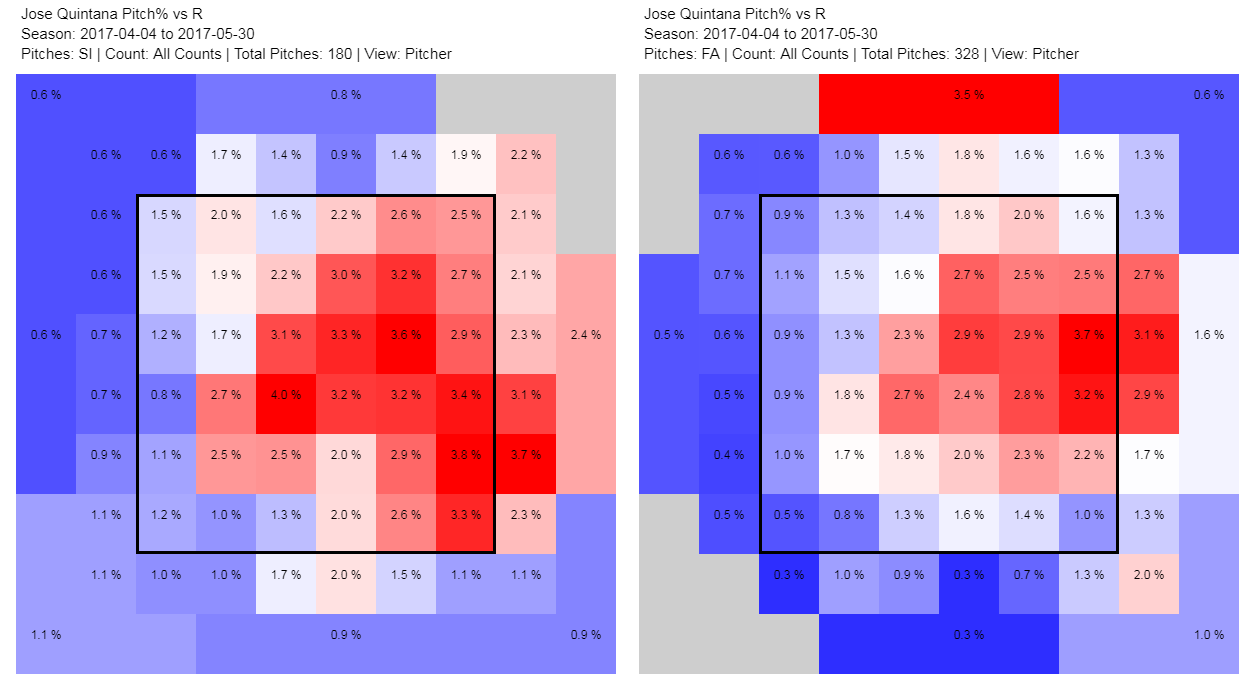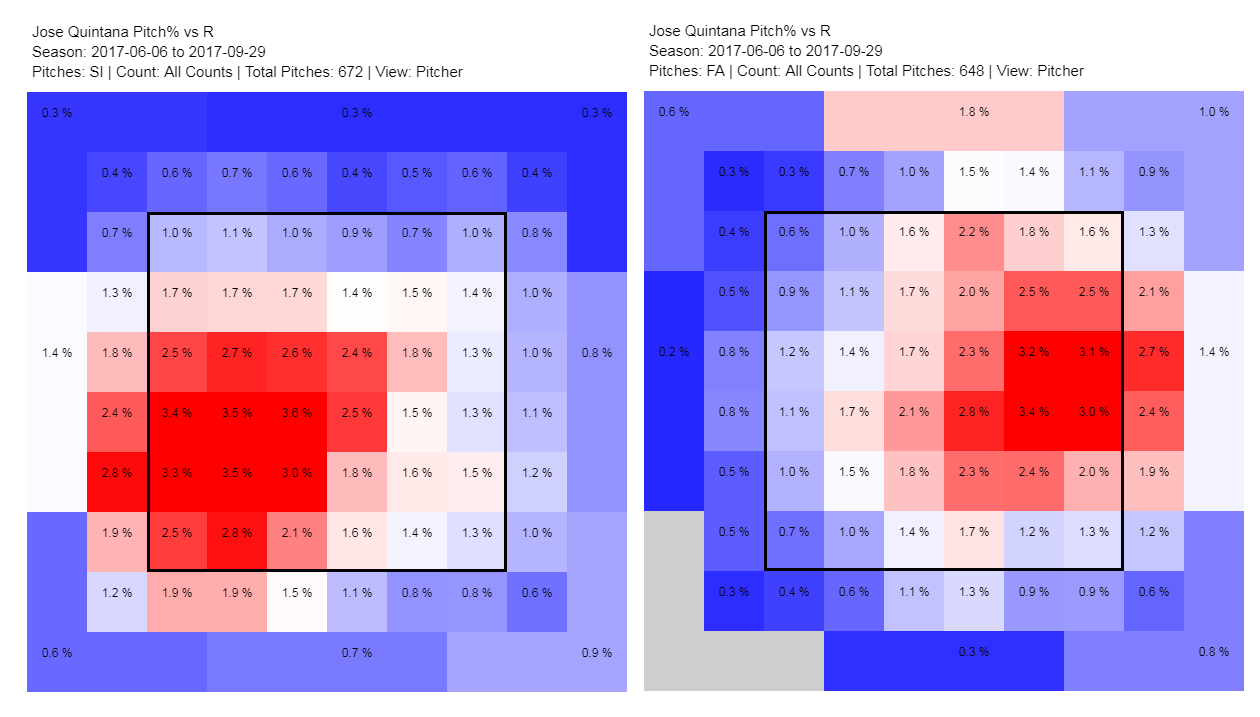Pitcher Spotlight: The Tweak In Jose Quintana’s Approach
This offseason, I’m taking the time to study the arms that deserve a little bit of extra attention. Sure, every starter should get a bit more than your standard gloss over, but you know Max Scherzer is a top tier starter and you’re aware that Andrew Cashner will not come close to repeating his 3.40 ERA. I can also imagine that Jose Quintana will be getting this standard treatment by many. You’re going to have some that consider him a stable arm and grab him as a #2 SP and you have others – myself included – that treat him as someone who will wait to see him fall before considering him for your staff.
But that was the old me. Quintana made a significant tweak in his approach this season and I didn’t know any better.
Let’s talk about the 32 starts Quintana made in 2017. The shallow numbers aren’t very encouraging – 4.15 ERA, a career-high 7.7% walk rate, with the first HR/FB rate above 10% since 2013 (near league average of 13.2%). Not atrocious, but certainly not what you’d expect from someone going around the #20th SP off the board in early mock drafts.
2017 was a tale of two halves for Quintana, though. Well, not two halves exactly, but the first 11 games compared to the final 21 were vastly different:
| K% | BB% | ERA | FIP | WHIP | |
|---|---|---|---|---|---|
| First 11 Starts | 23.0% | 8.6% | 5.60 | 4.40 | 1.40 |
| Final 21 Starts | 27.9% | 7.2% | 3.40 | 3.30 | 1.13 |
It doesn’t take much to see Quintana’s draft stock is a product of these final 21 games. Strikeouts went up to a career-high mark while his ERA and WHIP came down dramatically. That’s the Quintana that owners are paying for in the early mock drafts.
If you know me at all, whenever I see a shift in performance I dig under the hood to identify what adjustments were made. And that starts with his repertoire.
In previous seasons, the discussion surrounded his curveball. The pitch earned a 13.6 pVal in 2015, but it has been a disappointment since, tallying a -9.8 total pVal across the following two seasons. Maybe the low .244 BABIP was the catalyst for its 2015 success, maybe Quintana did a better job mixing the pitch. But the hook’s effectiveness was consistently mediocre across all of 2017 and not a variable in Quintana’s fluctuating season. Let’s move on.
If you look at Quintana’s sinker and four-seamer mix between 2016 and the two distinct groups of 2017, there’s something a little odd.
| FA Usage | FA pVal | SI Usage | SI pVal | |
|---|---|---|---|---|
| 2016 | 41.3% | 19.3 | 25.2% | 11.3 |
| 2017 First 11 Starts | 39.0% | 4.0 | 22.3% | -6.7 |
| 2017 Final 21 Starts | 31.0% | 12.1 | 32.4% | -4.3 |
Quintana had a great year with both his heaters in 2016, but when he ran into some trouble to start the 2017 season, he elected to throw more of the pitch that hurt him and less of the pitch he was having success with.
I’m not here to tell you why he did this. I can fathom a situation where he felt that he had reduced his sinker usage slightly too much at the start of the 2017 and it was affecting everything else, then overcompensated in the second half. It could be that he felt the results simply weren’t an expression of how he actually felt throwing the pitch. It could be many things, but in the end, it’s weird.
And while his increased affinity for the sinker is fascinating, what’s more intriguing to me is how he threw fewer four-seamers yet increased his success with the pitch. (Note: pVal is an accumulation stat. Even though the total amount of four-seamers thrown was higher across 21 starts despite the lower usage right, it doesn’t cover a full 200% growth of pVal.)
There could be multiple explanations for this, though I think I discovered what happened here. Let me direct you to a pair of images, both featuring heatmaps of Quintana’s sinker and four-seamer locations.
Here are his sinker and four-seamer heatmaps against RHB from the first 11 starts of the season:
And here are the same pitches against RHB from the final 21 starts of 2017:
It doesn’t get much more transparent than this. Quintana began throwing his sinker away from right-handers as he kept his four-seamers along the inside corner.
But this doesn’t seem right, does it? Quintana’s four-seamer didn’t change yet its success was amplified, while his sinker – despite changing locations – was still an ineffective pitch. Shouldn’t their results have been swapped?
Let’s think about this. Previously when batters saw fastballs, they were predominately on the same side of the plate. Quintana’s four-seamer stayed along the same path and would nip the inside corner if not jamming a bit inside the batter’s box, while his sinker would tail a bit toward the heart of the zone. This could work if we shifted everything an inch or two more inside, with sinkers catching the inside corner and four-seamers exclusively used to induce weak contact on balls out of the zone, but with this exact approach, batters were able to stay aggressive on fastballs and focus on one area when locked in for heat.
With Quintana’s shift in approach, both sides of the plate became open to attack with fastballs. Batters could be leaning a bit over the plate after seeing a sinker away, making four-seamers on the inner-half more effective and induce weak contact. Yes, his sinker was still a questionable pitch, but simply using it differently opened up the possibilities for his four-seamer to do damage.
Fastballs aside, we still have one more pitch to talk about, Quintana’s changeup.
In his final 21 games, Quintana boosted his changeup usage about three points from 7.1% to 10.2%. It’s far from a significant shift, yet suddenly its pVal went from -2.5 in the first 11 games to 5.1 in the final 21 and it makes perfect sense.
With a major focus on sinkers located on the outer half, Quintana was able to dangle his changeup off the outside corner as well, appearing to hitters as a fastball out of his hand before falling below the zone. This gets batters on their front foot and swinging over the ball, leading to groundballs (up from 26.8% in 2016 to 58.7% in 2017) and swings-and-misses (6.4% rate in 2016, 12.1% in 2017). Quintana’s sinker turned into the sacrificial lamb to let his four-seamer and changeup fufill their potential.
I’m sure you want to see this in action. Hell, I want to see this in action.
Here are two at-bats early from his September 12th game hosting the Mets. In the first he throws a sinker away, four-seamer inside, then a changeup away to get the groundout:
And here is the same sequence from a 0-1 count, leading to a foul ball, brushback back off the plate, then a whiff on a down-and-away changeup:
This is the new Quintana. I was once a lukewarm fan, skeptical of his ability to be a study #2/#3 starter for your squad, but I don’t see this new approach disappearing in 2018. His strikeout rate will most likely not soar above 27% again, though a 25% strikeout rate with a sub 3.50 ERA and WHIP under 1.20 appears to be a conservative bet.
I had ranked him past #30 in my way-too-early SP rankings back in October, but those were the old days. I’m moving him up to the 20-25 range and will be considering him heavily come drafts this year.
Nick Pollack is the founder of PitcherList.com and has written for Washington Post, Fantasy Pros, and CBS Sports. He can be found making an excessive amount of GIFs on twitter at @PitcherList.



Pitch sequencing is fascinating as are changes to pitch mixes in general and changes to pitch location (whether by moving on the rubber or a pitcher with good command changing their plan of attack). I was already a Quintana fan and I really appreciate this type of pitcher analysis. Thanks Nick – this is great!